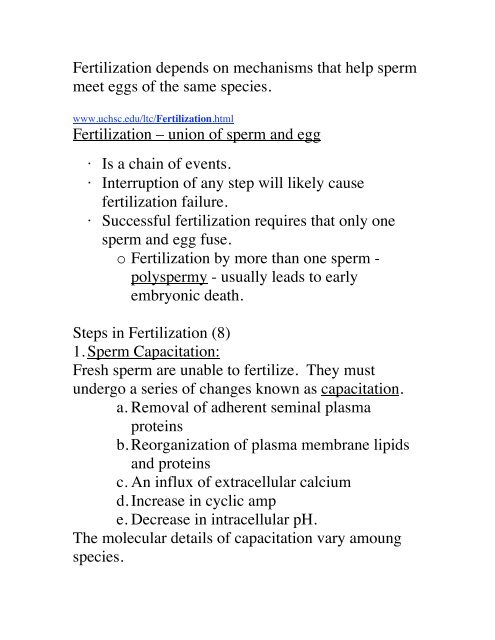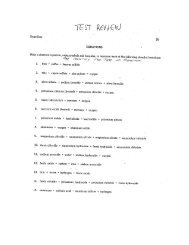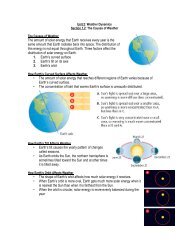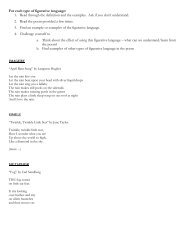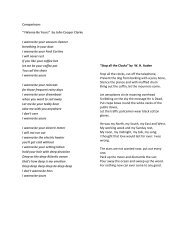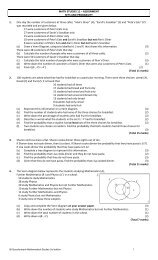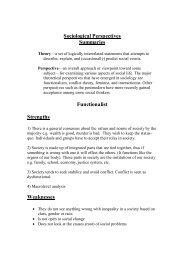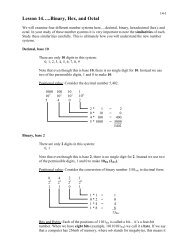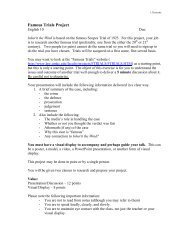Fertilization notes.pdf - HRSBSTAFF Home Page
Fertilization notes.pdf - HRSBSTAFF Home Page
Fertilization notes.pdf - HRSBSTAFF Home Page
You also want an ePaper? Increase the reach of your titles
YUMPU automatically turns print PDFs into web optimized ePapers that Google loves.
<strong>Fertilization</strong> depends on mechanisms that help sperm<br />
meet eggs of the same species.<br />
www.uchsc.edu/ltc/<strong>Fertilization</strong>.html<br />
<strong>Fertilization</strong> – union of sperm and egg<br />
· Is a chain of events.<br />
· Interruption of any step will likely cause<br />
fertilization failure.<br />
· Successful fertilization requires that only one<br />
sperm and egg fuse.<br />
o <strong>Fertilization</strong> by more than one sperm -<br />
polyspermy - usually leads to early<br />
embryonic death.<br />
Steps in <strong>Fertilization</strong> (8)<br />
1. Sperm Capacitation:<br />
Fresh sperm are unable to fertilize. They must<br />
undergo a series of changes known as capacitation.<br />
a. Removal of adherent seminal plasma<br />
proteins<br />
b. Reorganization of plasma membrane lipids<br />
and proteins<br />
c. An influx of extracellular calcium<br />
d. Increase in cyclic amp<br />
e. Decrease in intracellular pH.<br />
The molecular details of capacitation vary amoung<br />
species.
1. Capacitation occurs in the female reproductive<br />
tract<br />
2. The length of time required is usually several<br />
hours.<br />
3. The sperm of many mammals can also be<br />
capacitated by incubation in certain fertilization<br />
media.<br />
4. Sperm that have undergone capacitation are said<br />
to become hyperactiviated and display<br />
hyperactivated motility.<br />
5. Capacitation destabilizes the sperm's membrane<br />
to prepare it for the acrosome reaction<br />
2. Sperm-Zona Pellucida Binding<br />
· Binding of sperm to the zona pellucida of ova<br />
· is a receptor-ligand interaction with a high<br />
degree of species specificity.<br />
· Glycoproteins on the zona pellucida function<br />
as sperm receptors.<br />
· The sperm molecule that binds this receptor is<br />
not known<br />
3. Acrosome Reaction<br />
· Penetrating the zona pellucida to get to the<br />
oocyte.<br />
· Acrosome - a lysosome packed with zonadigesting<br />
enzymes<br />
· Located at anterior part of the sperm's head
· The acrosome reaction provides the sperm with<br />
an enzymatic drill to get throught the zona<br />
pellucida. The same zona pellucida protein that<br />
serves as a sperm receptor also stimulates a<br />
series of events that lead to many areas of fusion<br />
between the plasma membrane and outer<br />
acrosomal membrane. Membrane fusion<br />
(actually an exocytosis) and vesiculation expose<br />
the acrosomal contents, leading to leakage of<br />
acrosomal enzymes from the sperm's head.<br />
As the acrosome reaction progresses and the sperm<br />
passes through the zona pellucida, more and more of<br />
the plasma membrane and acrosomal contents are<br />
lost. By the time the sperm traverses the zona<br />
pellucida, the entire anterior surface of its head, down<br />
to the inner acrosomal membrane, is denuded. The<br />
animation to the right depicts the acrosome reaction,<br />
with acrosomal enzymes colored red.<br />
Sperm that lose their acrosomes before encountering<br />
the oocyte are unable to bind to the zona pellucida<br />
and thereby unable to fertilize. Assessment of<br />
acrosomal integrity of ejaculated sperm is commonly<br />
used in semen analysis.
Penetration of the Zona Pellucida<br />
The constant propulsive force from the sperm's<br />
flagellating tail, in combination with acrosomal<br />
enzymes, allow the sperm to create a tract through<br />
the zona pellucida. These two factors - motility and<br />
zona-digesting enzymes- allow the sperm to traverse<br />
the zona pellucida. Some investigators believe that<br />
sperm motility is of overriding importance to zona<br />
penetration, allowing the knife-shaped mammalian<br />
sperm to basically cut its way through the zona<br />
pellucida.<br />
Sperm-Oocyte Binding<br />
Once a sperm penetrates the zona pellucida, it binds<br />
to and fuses with the plasma membrane of the oocyte.<br />
Binding occurs at the posterior (post-acrosomal)<br />
region of the sperm head.<br />
The molecular nature of sperm-oocyte binding is not<br />
completely resolved. A leading candidate in some<br />
species is a dimeric sperm glycoprotein called<br />
fertilin, which binds to a protein in the oocyte plasma<br />
membrane and may also induce fusion. Interestingly,<br />
humans and apes have inactivating mutations in the<br />
gene encoding one of the subunits of fertilin,<br />
suggesting that they use a different molecule to bind<br />
oocytes.<br />
Egg Activation and the Cortical Reaction<br />
Prior to fertilization, the egg is in a quiescent state,<br />
arrested in metaphase of the second meiotic division.
Upon binding of a sperm, the egg rapidly undergoes a<br />
number of metabolic and physical changes that<br />
collectively are called egg activation. Prominent<br />
effects include a rise in the intracellular concentration<br />
of calcium, completion of the second meiotic division<br />
and the so-called cortical reaction.<br />
The cortical reaction refers to a massive exocytosis of<br />
cortical granules seen shortly after sperm-oocyte<br />
fusion. Cortical granules contain a mixture of<br />
enzymes, including several proteases, which diffuse<br />
into the zona pellucida following exocytosis from the<br />
egg. These proteases alter the structure of the zona<br />
pellucida, inducing what is known as the zona<br />
reaction. Components of cortical granules may also<br />
interact with the oocyte plasma membrane.<br />
The Zona Reaction<br />
The zona reaction refers to an alteration in the structure of the zona<br />
pellucida catalyzed by proteases from cortical granules. The critical<br />
importance of the zona reaction is that it represents the major block<br />
to polyspermy in most mammals. This effect is the result of two<br />
measurable changes induced in the zona pellucida:<br />
The zona pellucida hardens. Crudely put, this is analogous to the<br />
setting of concrete. Runner-up sperm that have not finished<br />
traversing the zona pellucida by the time the hardening occurs<br />
are stopped in their tracks.<br />
Sperm receptors in the zona pellucida are destroyed. Therefore,<br />
any sperm that have not yet bound to the zona pellucida will no<br />
longer be able to bind, let alone fertilize the egg.<br />
The loss of sperm receptors can be demonstrated by mixing sperm<br />
with both unfertilized oocytes (which have not yet undergone the zona
eaction) and two-cell embryos (which have previously undergone<br />
cortical and zona reactions). In this experiment, sperm attach avidly<br />
to the zona pellucida of oocytes, but fail to bind to the two-cell<br />
embryos.<br />
Post-fertilization Events<br />
Following fusion of the fertilizing sperm with the oocyte, the sperm<br />
head is incorporated into the egg cytoplasm. The nuclear envelope of<br />
the sperm disperses, and the chromatin rapidly loosens from its<br />
tightly packed state in a process called decondensation. In<br />
vertebrates, other sperm components, including mitochondria, are<br />
degraded rather than incorporated into the embryo.<br />
Chromatin from both the sperm and egg are soon encapsulated in a<br />
nuclear membrane, forming pronuclei. The image to the right shows a<br />
one-cell rabbit embryo shortly after fertilization - this embryo was<br />
fertilized by two sperm, leading to formation of three pronuclei, and<br />
would likely die within a few days. Pass your mouse cursor over the<br />
image to identify pronuclei.<br />
Each pronucleus contains a haploid genome. They migrate together,<br />
their membranes break down, and the two genomes condense into<br />
chromosomes, thereby reconstituting a diploid organism.


